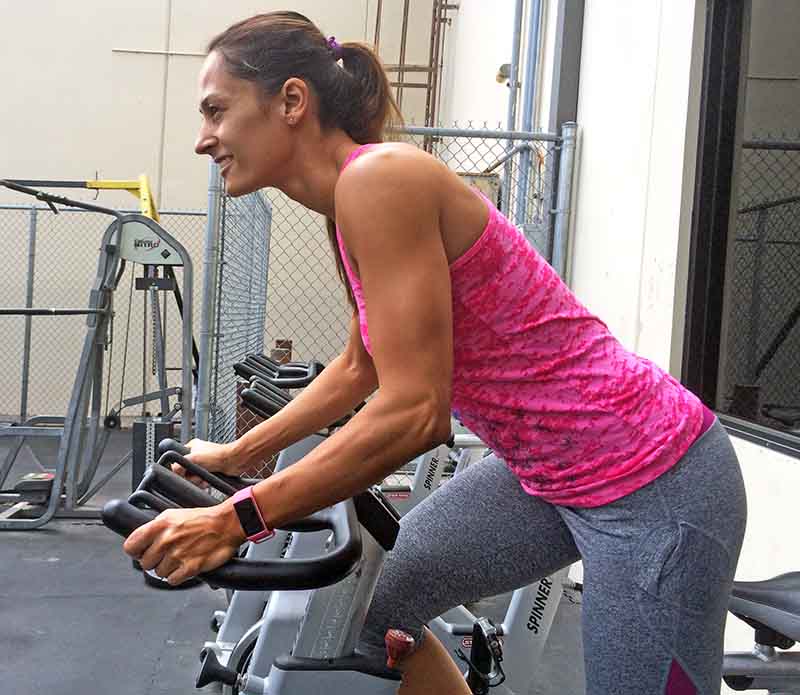This post may contain affiliate links. Please read our disclosure.
If you ask 100 people about their thoughts on fasted cardio, you’d probably get 100 different answers, coming down to two main themes:
- It is GREAT. You’ll get SUPER lean SUPER effectively.
- It is the worst thing in the world and will eat your hard-earned muscle. Avoid like the plague.
I’m here to give an objective look and let you make the decision for yourself.

What IS Fasted Cardio?
Contrary to popular belief, fasted cardio does NOT necessarily have to be immediately upon waking. Fasted is simply a post-absorptive, low insulin state, where food is no longer being digested.
As T1Ds, we know that our short-acting insulin has completed its activity within 4 hours, with the majority completed within 2-3 hours (1). While digestion can last a while depending on what has been eaten and how much has been eaten, you could theoretically do fasted cardio at times other than first thing in the morning.
What are the benefits?
The theory behind fasted cardio, especially early morning fasted cardio, is related to insulin, glycogen, and fat oxidation. Let me lay out the fast facts:
- High levels of insulin shift metabolism to utilize carbohydrates as the fuel of choice. Thus, it is very difficult to oxidize fat.
- After an overnight fast, the body will have used up much of its liver and muscle glycogen, which should allow the body to turn to fat as the most available energy source.
- Carbohydrates consumed at rest or prior to exercise will dramatically blunt fat burning. Since they’re used more easily, they take priority over fat.
What does all this say in English?
When fasted, your body should have low insulin, lesser glycogen, and no carbohydrates to block fat from being burned, which should THEORETICALLY lead to greater fat utilization and greater fat loss. One study demonstrated an additional 20% calories burned during fasted cardio (2).
Anecdotally, from myself and from others, it has also shown effectiveness in reducing levels of bodyfat in the “stubborn areas” like lower back and lower abs when bodyfat levels are already low (i.e. <10% in males, <18% in females).
What are the drawbacks?
- The intensity of your workout may drop. Because your body is not loaded up on energy from a recent meal, the workout you normally dominate may become more difficult.
- You may be more susceptible to injury due to the low energy state.
- You may unintentionally decrease physical activity through the rest of the day, thus lowering total energy expenditure…which would pretty much negate any additional benefit of fasted cardio.
- Cortisol levels may skyrocket, leading to multiple effects…I’m going to hit this one hard:
I mentioned our old stress hormone friend cortisol in my post about Avoiding High Morning Blood Sugars and he’s back again with the same mechanism! Levels are highest in the morning, and cortisol is like Pac-man for body tissue – it loves to eat it. What is its primary target? The muscle tissue that you have been working so hard to obtain.
Cortisol is smart: it also increases with cardio intensity or cardio duration. So, trying to outwit the hormone by choosing a longer, lower-intensity cardio session or choosing a quicker, higher-intensity session, you’re out of luck.
Cortisol can increase blood glucose levels quickly. More on this in a minute.
Fasted Cardio with T1D: Things to Consider
Some individuals with T1D find it easier to manage their blood sugars while doing fasted cardio because they don’t have any insulin or food onboard to adjust for, which can make it more predictable. Here’s some more points to consider:
HIIT Cardio
This is very individual-specific, as are most themes in T1D. But for many people with T1D, working out first thing in the morning WILL lead to an increase in blood sugar levels, especially if you choose to do a HIIT workout.
Why? Simple. Like I mentioned in the “How To Avoid High Morning Blood Sugars” post, the liver is going to recognize that energy is needed for activity and start dumping glucose into the bloodstream.
Since you are also inducing stress on your body in the form of exercise, catecholamines (i.e. epinephrine) will be released, mobilizing fat for energy (YAY!), but also mobilizing protein stores as well for gluconeogenesis and therefore, glucose (boo).
Thus, not one, but TWO mechanisms for raising blood sugar are about to come into play. So, you may need to take a small bolus and/or increase your basal to combat this forthcoming spike..I’ve spiked to 400 before from a pre-workout blood sugar of 90.
It can take a little bit of trial and error to get the right pre-workout bolus or basal increase down, so don’t give up!
Steady-State Cardio
This may not be as pronounced for the steady-state cardio crowd (i.e. distance runners), but is still something to watch for, as blood sugars will likely increase a bit.
For those of y’all who choose to work out fasted but not immediately upon waking (i.e. 4-5 hours post-meal with nearly 0 active insulin at the start), the effect on your blood sugar will be as one normally expects, simply due to previous energy intake. Food for thought.
Solving the Muscle Loss Conundrum
Want to start, but concerned about muscle loss?
One way to combat this is to take a scoop of whey protein pre-workout.
Would this still be considered as fasting? Tomato, To-mah-to. It’s not a real meal.
When I work out in a fasted state, I swear by a half scoop of whey for this reason, and I like to think I’m doing pretty ok.
What Should I Do?
It’s All About the Calories, Baby
If the goal is fat loss, one needs to be in a caloric deficit, plain and simple. At the end of the day, the difference between fueled and fasted cardio is not massive. It’s much more important to actually DO the cardio at a reasonable intensity than doing it fasted and hating your life.
If you can fit fasted cardio into your schedule (and it doesn’t feel like torture), by all means, do what you do, but don’t worry if you can’t. Put in the work, and you will reap the rewards.
References


Kaye
Hi! Great Article! I recently got tested for fasting blood sugar with a 110.09 mg/dl result. Doctor said I was prediabetic and so I need to make an effort to prevent and try to reverse diabetes. With this, I started overnight fasted workouts in the morning before breakfast since it is the most convenient time for me, and without realizing this might actually worsen it. From your article, am I doing it right? For 3 days already, I did 30 mins low-moderate exercises I found on youtube, after a 10-minute gentle yoga on bed and eat breakfast within an hour after. I haven’t checked my sugar yet during these times. Today, I ate 1 hard boiled egg before and another after workout. Should I eat more for breakfast? Or can this be sufficient? Thank you!
Christel Oerum
Nothing wrong with fasted cardio if you feel ok and don’t find that it messes too much with your blood sugar. Since you live with prediabetes you still have insulin production and a lot of the issues discussed in this article pertain to people living with type 1 diabetes. So unless your workouts are suffering due to the time and being fasting there’s no reason what you can’t continue with your routine.
We have some great prediabetes resources here: https://diabetesstrong.com/category/diabetes/prediabetes/